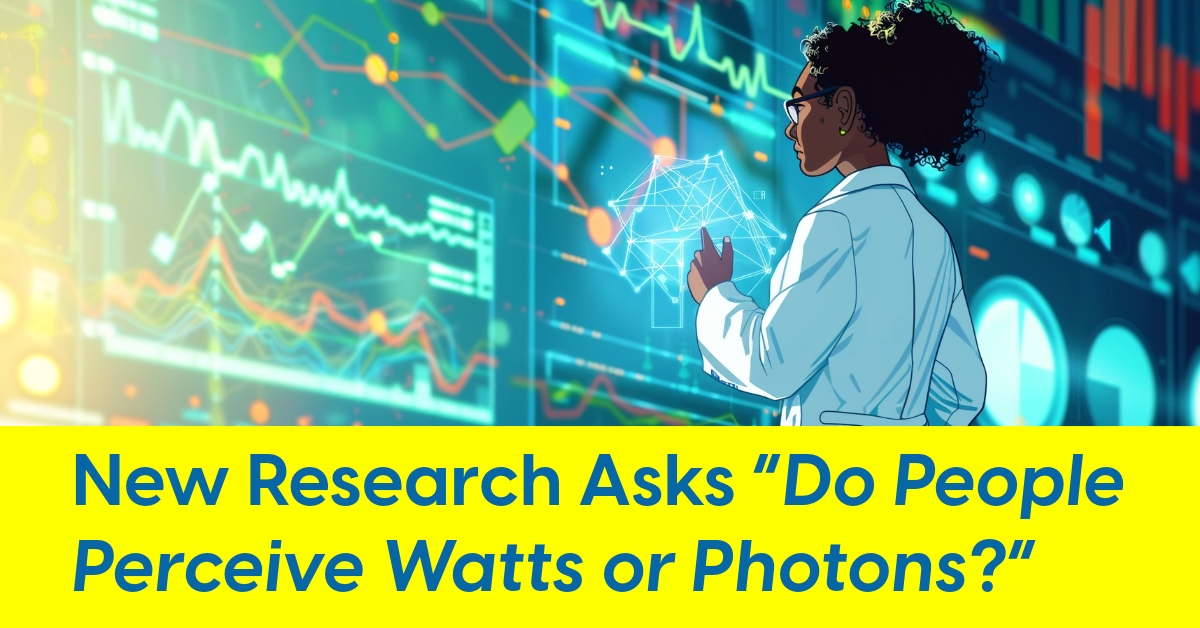May 2, 2024
New Research Asks “Do People Perceive Watts or Photons?”

Traditional watt-based measures may miss certain nuances in human light perception
In lighting research, understanding how light interacts with living things involves analyzing the spectral distribution of light. This concept, central to light measurement, is frequently interpreted using radiometric quantities like watts. However, a recent study led by Christophe Martinsons along with numerous other researchers proposes a re-evaluation of this practice. The paper, entitled Reconsidering the spectral distribution of light: Do people perceive watts or photons? emphasizes that considering the particle nature of light, especially its interaction at the photon level, might offer more accurate insights into light's biological effects.
Do people perceive watts or photons?
The research indicates that while traditional lighting studies have predominantly used radiometric quantities (watts) to measure light's spectral distribution, this might not fully capture the nuances of human perception. The spectral distribution plotted in the photon system reveals different peak positions and magnitudes compared to the watt-based system, suggesting that considering light at the photon level might provide a more accurate understanding of its effects on visual and non-visual systems. Thus, the study implies that photons, rather than watts, may be more relevant for accurately describing the human perception of light.
The spectral distribution of light is defined by the Commission Internationale de l'Éclairage (CIE) as the density of radiant, luminous, or photon quantities relative to wavelength. In lighting research, this is usually measured in terms of wavelength or frequency. However, transforming the spectral distribution from one variable to another isn’t straightforward; it involves significant mathematical transformations that can lead to several misconceptions. For instance, a commonly used white LED exhibits a shift in the spectral distribution peaks when switching between wavelength and frequency. The peak for phosphor emission changes from 565 nm (wavelength representation) to 583 nm (frequency representation), revealing the potential ambiguity of the spectral data.
Photon-Based Analysis and Its Implications
The study also explores how the spectral distribution of light changes when expressed in photon terms, significantly differing from the commonly used spectral power distribution (SPD). In this photon system, short-wavelength photons carry more energy than longer-wavelength ones, resulting in notable changes in the distribution peaks. For example, the photon-based spectral distribution of a white LED shows a shift of its phosphor emission peak from 565 nm (in the radiometric system) to 591 nm. This substantial change can influence how lighting professionals interpret data, especially when considering metrics like the blue-to-yellow ratio. Therefore, matching the system of units between spectral distribution and action spectra becomes crucial to avoid misleading conclusions.
This research stresses that the choice of whether to use radiometric or photon units should depend on the nature of the light-induced effects. Radiometric systems better describe thermal phenomena, while the photon-based system suits photobiological reactions, including visual and non-visual effects mediated by the eye. Applying photon-based units in experimental designs could yield more detailed insights into light's effects, particularly in low-light conditions. Consequently, Martinsons and his colleagues recommend that researchers clearly specify the system used in their studies to ensure accurate interpretation of data and results.
Martinsons and his team bring to light the importance of accurately defining spectral distributions when studying the effects of light. Given the potential for misleading interpretations, the paper urges researchers to carefully choose between radiometric and photon-based units based on the nature of the effects being studied. The study ultimately seeks to advance the field of lighting science by advocating for more precise measurements and more informed choices of spectral distributions.
RESEARCHERS:
- Christophe Martinsons
- Anthony Bergen
- Peter Blattner
- Michael Herf
- Claude Gronfier
- Kevin Houser
- Sophie Jost
- Maria Nilsson Tengelin
- Gael Obein
- Luc Schlangen
- Lionel Simonot
- Manuel Spitschan
- Jamie Zeitzer














